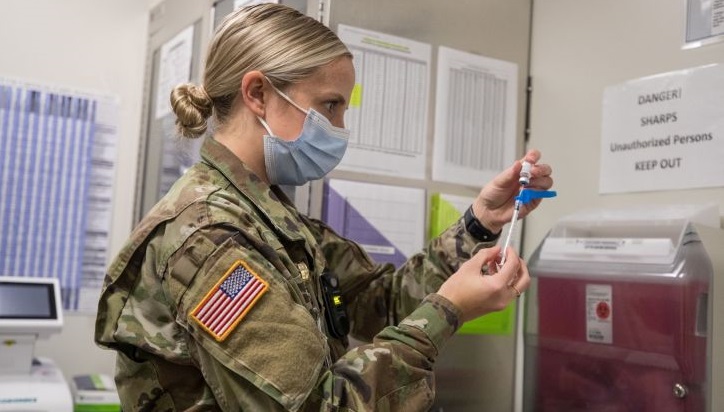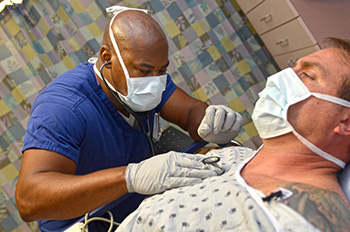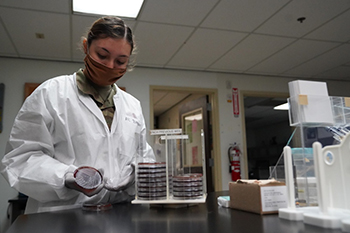MTF facilities, markets set to resume transition heading into 2021
 Army Capt. Patricia Nolan, a nurse, prepares vaccinations of the Pfizer-BioNTech COVID-19 at Madigan Army Medical Center on Joint Base Lewis-McChord in Washington on Dec. 16. Madigan is part of DHA’s Puget Sound market, scheduled to begin transition to the DHA in February. (Photo by John Wayne Liston, Madigan Army Medical Center.)
Army Capt. Patricia Nolan, a nurse, prepares vaccinations of the Pfizer-BioNTech COVID-19 at Madigan Army Medical Center on Joint Base Lewis-McChord in Washington on Dec. 16. Madigan is part of DHA’s Puget Sound market, scheduled to begin transition to the DHA in February. (Photo by John Wayne Liston, Madigan Army Medical Center.)
Despite the unforeseen impacts of the COVID-19 pandemic, the transition of military medical treatment facilities to the Defense Health Agency is on track headed into the new year, explained Dr. Barclay Butler, DHA’s assistant director for management.
The Department of Defense made the decision early in the pandemic to pause transition activities due to the unprecedented burden on the Military Health System. However, in November, the Department resumed transition activities.
The strategic pause ended up having a positive impact on the transition, Butler added.
“The pause in Military Health System transition let us compile a number of lessons learned,” Butler said. “We then applied those lessons learned to MHS reform. We also used the pause to improve the transition planning, and the transition products.”
Lessons learned included standardization of military health metrics reporting to the DOD. Previously, each military service reported that information separately to the DOD, but the DHA was able to demonstrate the value of collecting information and reporting it collectively. The four regional areas, known as ‘markets’ that have already transitioned to the DHA also demonstrated speed of response as a result of integrating their market MTFs into an integrated health system.
This information also served to inform the DOD’s COVID-19 Task Force.
“That speaks largely to the lesson learned regarding the COVID response and to the markets’ ability to respond,” Butler said.
 Navy Lt. Jeremiah Thompson, an emergency medicine physician assistant at Naval Hospital Jacksonville, checks Navy Chief Aviation Electrician’s Mate Robert Frehulfer’s heart. (Photo by Jacob Sippel, Naval Hospital Jacksonville.)
Navy Lt. Jeremiah Thompson, an emergency medicine physician assistant at Naval Hospital Jacksonville, checks Navy Chief Aviation Electrician’s Mate Robert Frehulfer’s heart. (Photo by Jacob Sippel, Naval Hospital Jacksonville.)
Butler added that one of the most important results of the past year was the confirmation that the DHA is progressing in the right direction with the market model, affirmed by the Department’s decision to continue the current plan.
“The services asked the Secretary to re-asses the approach and the Secretary took that information and made a decision on the 9th of November to continue forward with our plan,” Butler said.
Standardization across the military health enterprise, including clinical quality, is one example of how a market-based approach improves the quality of care for patients.
“Before the DHA started the transition, we found there were 38 different clinical quality standards in the MHS,” Butler said. “How many should we have? We should have one. When you get rid of unwanted variation, you see healthcare quality go up and costs go down.”
Going forward, Butler said, military medicine will be facing a ‘new normal.’ We will need to remain flexible, and adapt and react as we have over the past year.
“We don’t really know what that ‘new normal’ actually looks like, so we need that agility to be able to respond and continue to provide our patients with access to high quality care,” he said.
Hints of what is on the horizon include increased use of virtual health options.
“Use of virtual health has gone up thousands of percent from where we were pre-COVID pandemic” Butler said. “I think you’re going to continue to see a high utilization of our virtual health systems, which gives our patients greater access.”
In terms of facilities, the next step is transitioning five additional markets to the DHA.
“Our next five MTFs – Hawaii, Colorado, Puget Sound, San Antonio and Tidewater – will be stood up and operating as markets near the end of February,” Butler said. “That’s a big step for the DHA.”
He sees a relatively smooth transition, as all of the aforementioned were already Enhanced Multi-Service Markets, where multiple services have coordinated healthcare management for several years. Contrast that with remote single-service MTFs, such as Twentynine Palms in California and Minot Air Force Base in North Dakota, where these MTFs are “the only option,” and where the DHA will focus on providing support to these remote locations.
 Air Force Airman 1st Class Alexandria Johnson, 81st Diagnostic and Therapeutics Squadron lab technician, reviews a bacteria sample inside the Keesler Medical Center at Keesler Air Force Base, Mississippi in July 2020. (Photo by Airman 1st Class Spencer Tobler.)
Air Force Airman 1st Class Alexandria Johnson, 81st Diagnostic and Therapeutics Squadron lab technician, reviews a bacteria sample inside the Keesler Medical Center at Keesler Air Force Base, Mississippi in July 2020. (Photo by Airman 1st Class Spencer Tobler.)
Other focus areas, he said, include extending partnerships with entities such as the Department of Veteran’s Affairs, other federal institutions, academic medical centers, and other partners in order to improve effectiveness and efficiency.
Army Col. Christopher Ivany, director of the DHA’s Transition Program Management office, explained how the pandemic highlights the need for the military health system to be able to respond to large-scale crises with a single, cohesive approach.
Ivany said that the response across the National Capital Region, where a market with each of the services is already established, was a perfect example.
“In those areas where all the facilities, the people, the resources were all applied to this huge problem in a way that was focused on what was best for the beneficiaries as a whole, it was done more effectively across all service lines,” Ivany said. “It reiterated the need for the MHS transformation to go forward.”
Those successes, he said, have shaped how the DHA will move forward with the next set of markets.
“The MHS is in the midst of a fundamental shift in how it manages healthcare, and while that shift can and will be difficult at times, the end state of where this change is going will have significant benefits for our patients, for our staff and for the medical readiness of the line units, and the healthcare teams themselves.”
Butler’s message to MHS patients is that the quality of their care is paramount.
“The DHA and the MHS are focused on delivering high-quality care to our beneficiaries. That high-quality care translates into having our care teams ready to do their deployed mission while it produces readiness for the department,” Butler said.
“Lieutenant General Place, the director of the DHA, is focused in on great outcomes. The number one great outcome is a medically ready force, without a doubt,” Butler said. “That’s what he wants us to do, and that’s what we do.”